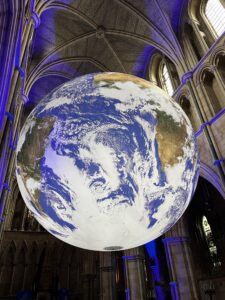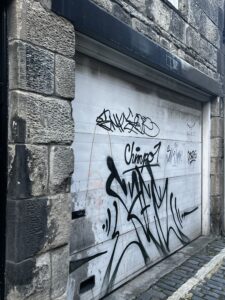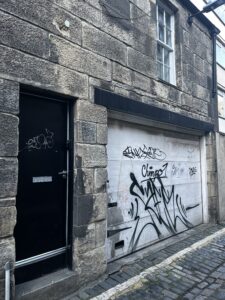Week 1 Major And Minor Curatorial Project + Interview Summary
Major curatorial projects
-
GAIA
Address:St John the Baptist Church

The Gaia World installation is a touring artwork designed by Luke Jerram.
Created in partnership with the Natural Environment Research Council (NERC), Bluedot and the UK Association for Science and Discovery Centres.
The installation aims to create a sense of the Overview Effect, which was first described by author Frank White in 1987. Common features of the experience for astronauts are a feeling of awe for the planet, a profound understanding of the interconnection of all life, and a renewed sense of responsibility for taking care of the environment.

Unlike the Moon, which we have been gazing at for thousands of years, the first time humans saw the entire Earth as a blue marble floating in space was during NASA’s Apollo 17 mission in 1972. This was the moment when our view and understanding of the Earth was changed forever. Suspended in the dark emptiness of space, the Earth seemed isolated, an island of precious and fragile life. From a distance, the Earth is just a pale blue dot.
And the Curator said“I hope visitors to Gaia get to see the Earth as if from space; an incredibly beautiful and precious place. An ecosystem we urgently need to look after – our only home. Halfway through the Earth’s sixth mass extinction, we urgently need to wake up, and change our behaviour.”
“We need to quickly make the changes necessary, to prevent run away Climate Change.”
I do feel the same way, and I totally agree with the curator that environmental issues are problems that we cannot ignore, and that we cannot solve them by remaining blind to them. One has to think about the relationship between people and nature, between people and the earth, this amazing and beautiful earth. We always have to face these issues and it is the responsibility of artists and curators, as well as social organisations and institutions, to wake people up.
Minor curatorial projects

I went to two examples of Minor’s exhibitions recommended by Beth: Embassy Gallery and Rhubaba Gallery.
Embassy Gallery Address: 3ly, 10B Broughton St Ln, Edinburgh EH1 3LY
Rhubaba Gallery Address: 25 Arthur St, Edinburgh EH6 5DA
I went to both exhibitions on Thursday after classes ended, but, very unfortunately, both galleries were closed at the time.
Embassy Gallery:


Rhubaba Gallery:


Summary of curatorial interview
The curator I have chosen is PILI, a Chinese curator. The reason for this is that I was keen to find out something about Chinese contemporary art and curating in Asia. What I noticed throughout the interview were some of the problems and resistance to Chinese contemporary art that PILI mentioned, and the following points are very typical and thought-provoking situations in my opinion.
The first is the late start of contemporary art in China, which only began in the 1980s, also because the Chinese people at that time had been freed from the problem of food and clothing and had begun to rise to the level of spiritual pursuits. But the long-standing artistic and cultural restrictions also led to the fact that one would be surprised that the government allowed the new art magazine to disseminate international and local art more widely.
Secondly, PILI has mentioned the Tiananmen Square incident, and in the path of China’s art development we can see that there were indeed many events that led to the slow development of contemporary art, events that were inevitable for Chinese artists. I can’t imagine how heartbroken the artists were when emerging artistic ideas were stifled, for example, when PILI’s father’s magazine was closed down.
Then there was the fact that the world was, at times, prejudiced against contemporary Chinese artworks and exhibitions. For example, the French exhibition La Chine ( How about China) in 2003, mentioned in the interview, France looked at China with exotic political overtones. For example, PILI also realised after winning an award at the Cannes Film Festival that the China the world wanted to see was not the China we knew. Not limited to China, any curator or artist who wants to understand the culture of other countries needs to make work with an objective and realistic perspective. Both curators and artists should have their own bottom line and should not allow art and culture to become a weapon of political rights.
Then there are policies in China that have forced art to become for-profit and commercial. The interview mentions that PILI wanted to open a non-profit gallery, but the plan was scrapped because of the 15% tax to be charged. Moreover, some of the artists trained by PILI have chosen to sign with well-known galleries after they have become famous, leading to an increasing commercialisation of these artists.
Finally, the PILI’s argument that “the combination of art and technology poses a danger to art”. Until now I have always thought that the combination of art and technology has made art more diverse, richer and more experiential. But I had never thought of technology as a danger to art, because the viewer’s attention is shifted to the technology and the strange visual experience, thus losing sight of the idea of art. This is a point that deserves the attention of curators and artists alike. If we are so obsessed with stunning visual effects and experiences that we lose sight of the profundity of the artistic concept, the future development of the art field will become limiting.




Recent comments